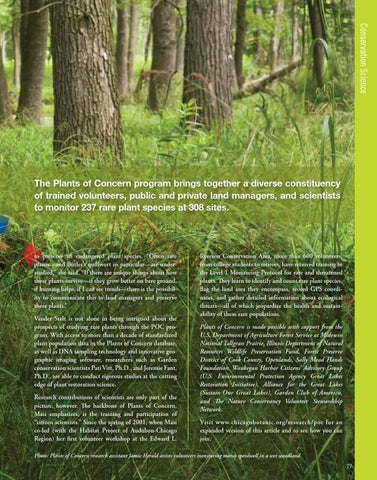Conservation Science
Antiques & Garden Fair The Plants of Concern program brings together a diverse constituency of trained volunteers, public and private land managers, and scientists to monitor 237 rare plant species at 308 sites.
to preserve an endangered plant species. “Often rare plants—and Butler’s quillwort in particular—are understudied,” she said. “If there are unique things about how these plants survive—if they grow better on bare ground, if burning helps, if I can see trends—there is the possibility to communicate this to land managers and preserve these plants.” Vander Stelt is not alone in being intrigued about the prospects of studying rare plants through the POC program. With access to more than a decade of standardized plant population data in the Plants of Concern database, as well as DNA sampling technology and innovative geographic imaging software, researchers such as Garden conservation scientists Pati Vitt, Ph.D., and Jeremie Fant, Ph.D., are able to conduct rigorous studies at the cutting edge of plant restoration science. Research contributions of scientists are only part of the picture, however. The backbone of Plants of Concern, Masi emphasizes, is the training and participation of “citizen scientists.” Since the spring of 2001, when Masi co-led (with the Habitat Project of Audubon-Chicago Region) her first volunteer workshop at the Edward L.
Ryerson Conservation Area, more than 600 volunteers, from college students to retirees, have received training in the Level 1 Monitoring Protocol for rare and threatened plants. They learn to identify and count rare plant species, flag the land area they encompass, record GPS coordinates, and gather detailed information about ecological threats—all of which jeopardize the health and sustainability of these rare populations. Plants of Concern is made possible with support from the U.S. Department of Agriculture Forest Service at Midewin National Tallgrass Prairie, Illinois Department of Natural Resources Wildlife Preservation Fund, Forest Preserve District of Cook County, Openlands, Sally Mead Hands Foundation, Waukegan Harbor Citizens’ Advisory Group (U.S. Environmental Protection Agency Great Lakes Restoration Initiative), Alliance for the Great Lakes (Sustain Our Great Lakes), Garden Club of America, and The Nature Conservancy Volunteer Stewardship Network. Visit www.chicagobotanic.org/research/poc for an expanded version of this article and to see how you can join.
Photo: Plants of Concern research assistant Jamie Herald assists volunteers monitoring marsh speedwell in a wet woodland. 27 www.chicagobotanic.org
27
